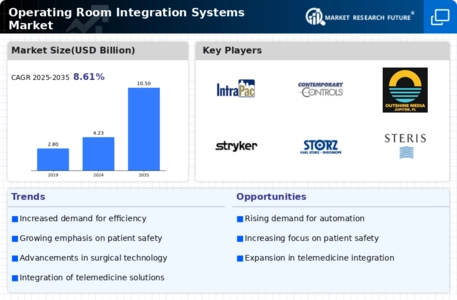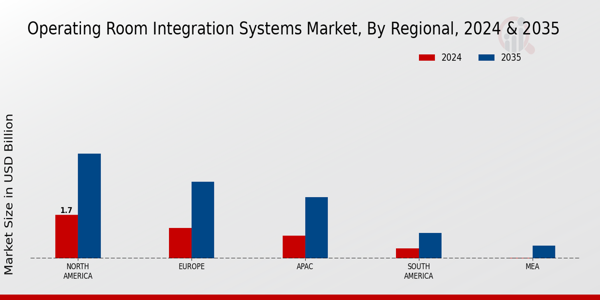Market Trends
Key Emerging Trends in the Operating Room Integration Systems Market
India has emerged as a highly sought-after destination for medical care, owing to concerted efforts by the government and corporate sectors in promoting the healthcare sector. This strategic emphasis has significantly propelled the country into a favored hub for medical tourists. Visitors seeking medical treatment in India predominantly pursue a wide spectrum of procedures, including joint replacement surgeries, spine and brain surgeries, organ transplants such as liver, heart, and bone marrow, treatments for cancer and kidney ailments, and in-vitro fertilization procedures.
The appeal of India as a medical tourism destination extends beyond its borders, attracting patients from regions like the Middle East and Africa. A key driving factor for these individuals is the lack of adequate medical facilities in their home countries. Consequently, seeking superior healthcare services in India becomes an imperative choice for patients seeking specialized treatments that may not be readily available in their local healthcare infrastructure. Conversely, patients from Europe and the United States predominantly gravitate towards India for cosmetic surgeries, leveraging the expertise and cost-effectiveness offered by Indian healthcare facilities in this domain.
According to reports from the Indian Brand Equity Foundation, the medical tourism industry in India witnessed substantial growth, estimated to reach a valuation of USD 6 billion by the culmination of 2018. This staggering growth projection reflects a significant escalation from its USD 3 billion valuation in 2017, marking an approximate Compound Annual Growth Rate (CAGR) ranging between 22% to 25%. The profound growth trajectory experienced by the Indian medical tourism industry is poised to foster the entry of new market players into this domain. As a result, the landscape of healthcare tourism in India is anticipated to witness substantial opportunities for expansion and development during the forecast period.
This rapid growth trajectory of medical tourism in India is underpinned by a multitude of factors. Primarily, the convergence of world-class healthcare facilities, a highly skilled medical workforce, and advanced technological infrastructure has bolstered India's reputation as a global healthcare destination. The cost-effectiveness of medical treatments in India, coupled with the availability of state-of-the-art medical technologies and internationally accredited hospitals, contributes significantly to the country's allure for medical tourists seeking high-quality yet affordable healthcare services.
Moreover, India's diverse cultural heritage and rich historical attractions offer an added incentive for medical tourists, providing opportunities for recuperation and post-treatment relaxation in a culturally enriching environment. The combination of top-tier medical facilities and a vibrant cultural landscape has contributed to positioning India as a holistic destination that caters not only to the medical needs but also to the overall well-being and rejuvenation of international patients.
The burgeoning growth of medical tourism in India not only benefits patients seeking specialized treatments but also contributes significantly to the country's economic landscape. The influx of medical tourists injects substantial revenue into the healthcare sector, thereby bolstering the nation's economy and creating employment opportunities across various facets of the healthcare industry.
In essence, India's ascendancy as a leading global healthcare tourism hub stems from a harmonious amalgamation of exceptional medical expertise, cutting-edge technology, cost-effective treatments, and a rich cultural tapestry. This convergence positions India as a compelling destination for individuals seeking not only top-notch medical care but also an enriching and memorable experience, marking the country as a beacon of excellence in the realm of healthcare tourism.














Leave a Comment